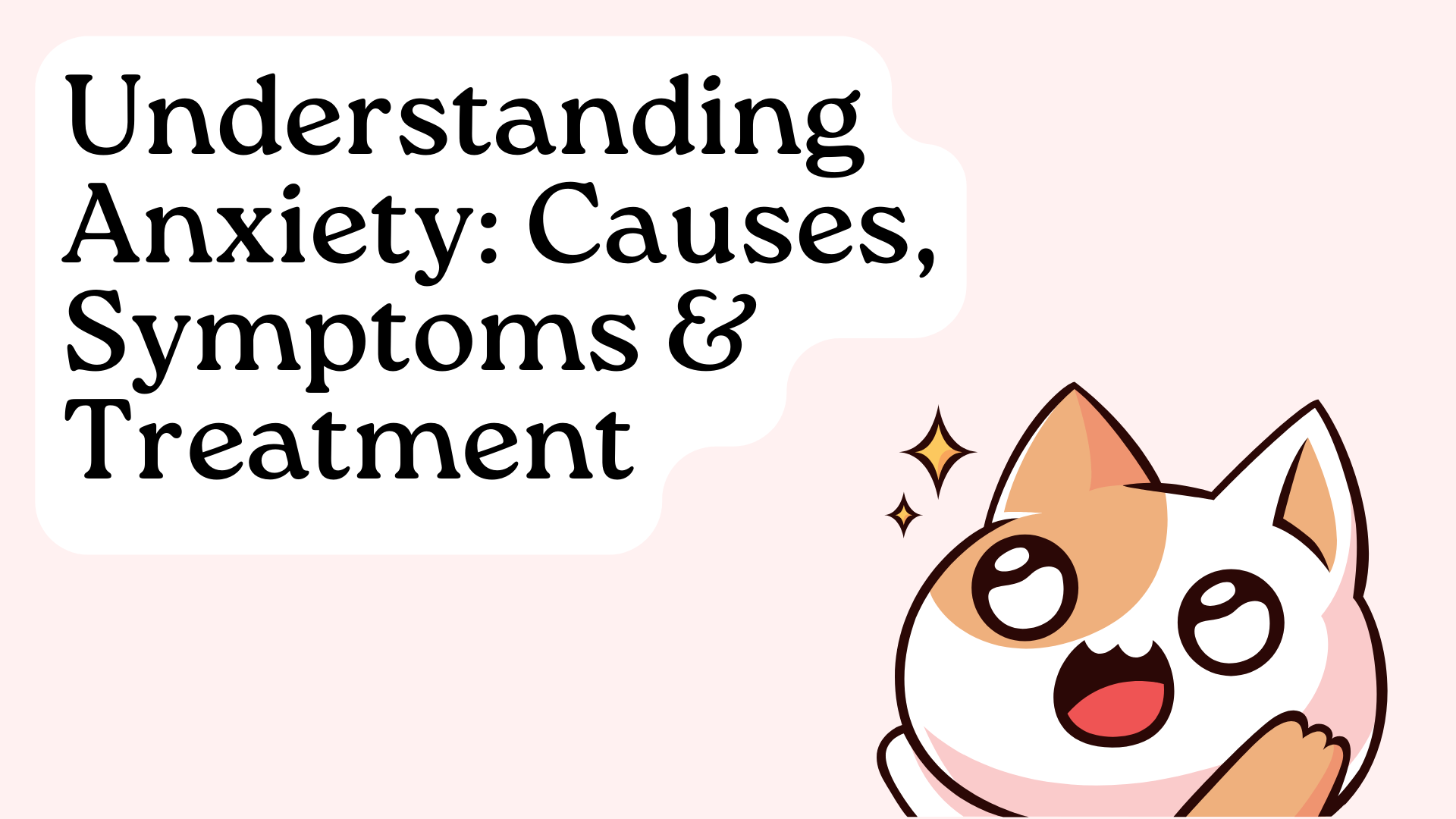Understanding Anxiety: Causes, Symptoms & Treatment

What is Anxiety?
Anxiety is a feeling of worry, nervousness, or unease about something with an uncertain outcome. It is a normal and often healthy emotion, but it can become overwhelming and interfere with daily activities when it is persistent and excessive. Anxiety disorders, such as generalized anxiety disorder, panic disorder, and social anxiety disorder, are characterized by excessive, irrational fear or dread and can lead to physical symptoms such as increased heart rate and difficulty breathing. Anxiety can be treated with therapy, medication, and lifestyle changes.
Overview: Anxiety is a normal and often healthy emotion, but it can become overwhelming and debilitating when it persists and interferes with daily life. Anxiety disorders form a category of mental health diagnoses that lead to excessive nervousness, fear, apprehension, and worry. These disorders alter how a person processes emotions and behaves, also causing physical symptoms. Anxiety disorders are some of the most common mental health disorders, and they can range in severity from mild to severe.
Types of Anxiety
- Generalized Anxiety Disorder (GAD): A condition characterized by excessive and unrealistic worry about everyday events, activities, and situations. People with GAD experience excessive anxiety and worry about various aspects of their lives, such as health, finances, and relationships, even when there is little or no reason to be concerned.
- Panic Disorder: A condition characterized by recurrent and unexpected panic attacks, which are sudden episodes of intense fear or discomfort that can include physical symptoms such as palpitations, sweating, and trembling. People with panic disorder may also experience anticipatory anxiety and worry about when the next panic attack will occur.
- Social Anxiety Disorder (SAD): A condition characterized by excessive fear and avoidance of social situations or performance situations, such as public speaking or interacting with strangers. People with SAD may experience intense anxiety and self-consciousness in social situations, which can lead to isolation and avoidance of social interactions.
- Specific Phobia: A condition characterized by excessive fear and avoidance of specific objects or situations, such as heights, animals, or flying. People with specific phobias may experience intense anxiety and panic when confronted with the object or situation they fear.
- Obsessive-Compulsive Disorder (OCD): A condition characterized by recurrent and persistent thoughts, impulses, or images (obsessions) that cause anxiety, and repetitive behaviors or mental acts (compulsions) that are performed to reduce the anxiety caused by the obsessions. People with OCD may experience intense anxiety and distress due to their obsessions and compulsions, which can significantly impact their daily lives.
-
Post-Traumatic Stress Disorder (PTSD): A condition characterized by intense anxiety, flashbacks, and avoidance behaviors following a traumatic event, such as a natural disaster, combat, or a physical or sexual assault. People with PTSD may experience intense anxiety and distress related to the traumatic event, which can lead to avoidance of reminders of the event and difficulty functioning in daily life.
Anxiety Causes
- Genetics: Anxiety disorders tend to run in families, suggesting that there may be a genetic component to the development of these conditions.
- Trauma or stress: Trauma or stressful life events, such as the death of a loved one, a car accident, or a natural disaster, can trigger anxiety disorders.
- Brain chemistry: Imbalances in certain brain chemicals, such as serotonin and dopamine, can contribute to anxiety disorders.
- Medical conditions: Certain medical conditions, such as heart disease, thyroid disorders, and diabetes, can cause anxiety symptoms.
- Substance abuse: The use of drugs and alcohol can worsen anxiety symptoms and increase the risk of developing an anxiety disorder.
- Personality traits: People who are prone to worry, have low self-esteem, or are perfectionists may be more likely to develop anxiety disorders.
- Social and environmental factors: Social isolation, poverty, and living in a high-stress environment can increase the risk of developing an anxiety disorder.
Symptoms
- Constant worrying or rumination about a variety of topics
- Difficulty concentrating or focusing on tasks
- Restlessness or feeling on edge
- Physical symptoms such as a rapid heartbeat, sweating, and muscle tension
- Avoiding certain situations or activities due to fear or discomfort
- Difficulty sleeping or insomnia
- Irritability or mood swings
- Difficulty controlling or managing negative thoughts
- Feelings of hopelessness or helplessness
- Persistent feelings of dread or fear.
Treatment of Anxiety
- Therapy: Cognitive Behavioral Therapy (CBT) and Exposure Therapy are commonly used to treat anxiety disorders. These therapies help individuals identify and change negative thought patterns and behaviors that contribute to their anxiety.
- Medication: Antidepressants and anti-anxiety medications can be prescribed to help manage symptoms of anxiety. These medications can include selective serotonin reuptake inhibitors (SSRIs), benzodiazepines, and beta-blockers.
- Relaxation techniques: Techniques such as deep breathing exercises, progressive muscle relaxation, and yoga can help reduce anxiety symptoms and promote relaxation.
- Mindfulness-based therapies: Mindfulness-based therapies, such as Mindfulness-Based Stress Reduction (MBSR), can help individuals develop mindfulness skills to manage anxiety and stress.
- Alternative therapies: Alternative therapies such as acupuncture, massage therapy, and herbal supplements may be beneficial for some individuals with anxiety disorders.
- Lifestyle changes: Making changes to diet and exercise, getting enough sleep, and reducing alcohol and caffeine intake can help manage symptoms of anxiety.
- Support groups: Joining a support group for individuals with anxiety disorders can provide a sense of community and a source of support and encouragement.
In conclusion, at Careme Health, we understand that every individual’s experience with anxiety is unique. That’s why we provide customized treatment plans, tailored to each patient’s specific needs and goals. Our team of experts uses a combination of evidence-based therapies and medications to deliver affordable and proven results in the treatment of anxiety. We believe that everyone should have access to the mental health care they need, and we strive to make our services as accessible and affordable as possible. Whether you are struggling with mild or severe anxiety, we are here to help you find the support and resources you need to feel better.
Related Articles

Letting Go With Grace: Emotional Tools for Closure
Letting go is never easy. Whether we are parting ways with a loved one, ending a relationship, leaving a job, or saying goodbye to a cherished chapter of life, the emotional weight can feel overwhelming. Yet, closure is essential for our emotional well-being. Without it, we carry unresolved grief, anger, regret, or longing that can seep into new relationships and experiences, holding us back from healing and growth.

Breakup Blues: How to Cope and Rebuild Your Self-Worth
A breakup often feels like a silent earthquake—unseen by others but devastating within. The pain doesn’t just come from the loss of a relationship, but from the crumbling of the life, identity, and future you built with another person. You may find yourself questioning your worth, doubting your value, and feeling isolated even when surrounded by people. In Indian society, where emotional expression is often discouraged and breakups can be stigmatized, this pain may feel even more overwhelming. But the truth is—while breakups may shake you, they do not define you. You are not broken; you are in a process of emotional reformation. And with the right tools, guidance, and support system, you can rebuild not just your self-worth but also your entire life narrative.

Healing After Heartbreak: A Mental Health Perspective
Heartbreak doesn't just break your heart—it can shatter your sense of identity, peace, and purpose. Whether the end was expected or abrupt, mutual or one-sided, short-lived or long-term, the aftermath often leaves people emotionally disoriented. In Indian culture, where societal expectations and family involvement in romantic relationships are prevalent, the pain is not just personal—it is public. Yet, very few are taught how to heal from emotional loss in a healthy, sustainable way.

Boundaries in Love: Saying ‘No’ Without Guilt
Love, in its truest form, should be a safe space—a space where individuality is not only respected but celebrated. Yet, in many relationships, especially in the Indian cultural context, love is often misunderstood as constant availability, complete sacrifice, and putting the other person first, always. As noble as this may sound, this version of love often leads to emotional exhaustion, suppressed resentment, and the erosion of one’s identity.

Gaslighting in Relationships: What It Is and How to Heal
Gaslighting is a form of emotional abuse that erodes your ability to trust your own perception. It’s a slow, insidious process that often begins with subtle doubts and ends with complete self-questioning. In romantic relationships—especially in the Indian context where silence, compromise, and duty are often mistaken for love—gaslighting can be even harder to recognize.

How Depression Can Affect Your Relationship—And What You Can Do
Depression is not just an internal struggle—it ripples outward, affecting relationships, routines, and the emotional fabric that holds people together. When someone is dealing with depression, it's not only their world that becomes dim—it can cast a shadow over their most intimate connections too. In a country like India, where open conversations about mental health are still rare and love is often equated with endurance, depression within a relationship can become invisible, misunderstood, or misjudged.
